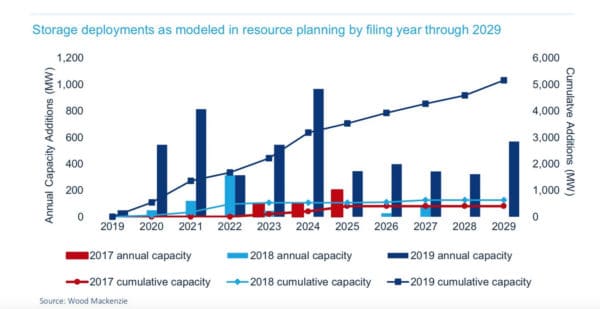Falling battery costs, shifting utility strategies and new PUC policies are drawing fresh entrants and incumbents into an invigorated energy storage sector.
We profile three energy storage industry aspirants today: Kore Power and its big battery, KiloVault’s 7.5-kW-hr wall-mount energy storage unit and NeoVolta’s 24 kw-hr residential storage entry.
- We covered Yotta Energy’s distributed batteries mounted under modules last week.
- SolPad gave pv magazine an update on its distributed storage and solar product.
The California residential battery market is going to explode this year, according to BNEF, which expects 50,000 residential battery systems to be installed his year — up from the 19,000 California homes that had batteries in 2019.
There are several gigawatts worth of large-scale energy storage on utility integrated resource plans. The energy storage market is expected to surge tenfold from 2018 to 2023, rising to $5 billion annually, according to Wood Mackenzie.

Kore Power’s 110 kw-hr rack-mounted battery system is intended for front-of-the-meter, multi-megawatt applications attached to a solar project, “utility arbitrage, especially in Texas,” as well as behind-the-meter demand-charge reduction applications, according to Tom DeRosa, VP of business development, in an interview with pv magazine.
The 18-employee company’s management has roots in mining as well as a partnership with DFD, a firm DeRosa called the DuPont of China, and a supplier of anode, cathode and electrolyte materials to customers such as CATL, BYD, Tesla and Panasonic.
DeRosa explains that DFD realized “they owned the supply chain and decided to build batteries.” He said that DFD has deployed nine million cells into the EV market to customers such as Chery International.
DFD’s battery formulation is NMC lithium-ion with nickel, manganese and cobalt in a 6-3-1 ratio — “down to one part cobalt,” said DeRosa who suggested that the “next advancement is 8-1-1” but that was “many years out.”
DeRosa said that Kore will sell to and work with developers and IPPs. Kore will bring in integrator partners — in order to offer a fully commissioned containerized solution.
KiloVault’s 7.5 kW-hr wall-mount energy storage system for residential and commercial applications is based on a lithium iron phosphate (LiFePO4) battery chemistry — making the unit safer for indoor mounting. Up to 14 units can be wired in parallel to provide up to 3.3 MWh of storage per month. After 4,000 cycles at 80% depth-of-discharge, the battery will retain 80% or more of its original 7.5 kWh storage capacity, according to the vendor. The battery is backed with a 7.5-year warranty.
The 7.5 kw-hr unit sells for $4,995 at the Alternative Energy Store and weighs 207 pounds.
NeoVolta’s CEO Brent Wilson spent 31 years in the Marine Corps working with enormous budgets on program management and maintenance of immense fleets of “highly complex machines.”
Hopefully, that prepared him for the residential energy storage industry.
Wilson studied the market in 2017, looking for the best designs. “Sonnen has the best product, but it’s $26,000 installed. Tesla has the right prices, but I don’t like the battery chemistry.”
With backing from “VC buddies,” he helped design and build a residential battery that addresses some of his concerns. It uses a lithium iron-phosphate battery that the CEO says weighs more, costs more, but it won’t catch on fire, “we’re only moving it once — and the cost will come down over time.”‘
The CEO claims his firm has met the Tesla price, while giving better performance — he quoted the company’s 8.4 kW unit at $18,500 fully installed. Wilson said, “Tesla says they power the whole home — that’s not true. The home is asking for 60A and only 20A is supplied by Tesla. The 240 [volt circuits] and oven are not being powered by Tesla.”
This content is protected by copyright and may not be reused. If you want to cooperate with us and would like to reuse some of our content, please contact: editors@pv-magazine.com.








“Wilson studied the market in 2017, looking for the best designs. “Sonnen has the best product, but it’s $26,000 installed. Tesla has the right prices, but I don’t like the battery chemistry.”
The pros and cons of energy storage as a whole. NMC more energy dense, but can be driven into thermal run away during use, LiFePO4 more stable less power dense and usually lower voltage power packs in the 48VDC range. (LTO), the titanium based battery technology is the least power dense technology but can last up to 20,000 plus cycles without degradation when kept at or above 80% DoD. Again more likely to be used in 48VDC energy storage systems and the cost per kWh of LTO is a little higher than other battery chemistries being manufactured at this time. Solid state battery chemistries or semi-solid state (24M) battery chemistry could bring on the ESS that doesn’t need an advanced BMS, fire suppression system or special cooling/heating to get the ‘most’ from the battery pack at variable ambient temperature operating points. IF the industry can find that really dirt cheap battery chemistry that doesn’t need volatile electrolytes, then one could set up an ESS like the old lead/acid technology at about 30 to 45Wh/kg and just run the charge/discharge cycles forever. A little chemistry ‘magic’ by replacing Lithium, Cobalt, Nickel with Sodium, Iodine, Magnesium, Copper, Zinc could make that chemistry more power dense and get one out of the lower end up to the 300 to 400Wh/kg neighborhood. One company says ‘they’ have the dirt cheap technology of the future, a clay, metal oxide chemistry that is inert and (can) be manufactured at quantity with a nominal power density of around 600Wh/kg. Sustainable Energy Inc. believes their technology could be ‘tweaked’ to around 1200Wh/kg. That power density right there could replace gasoline as an energy source using the efficiency of all electric drive trains.